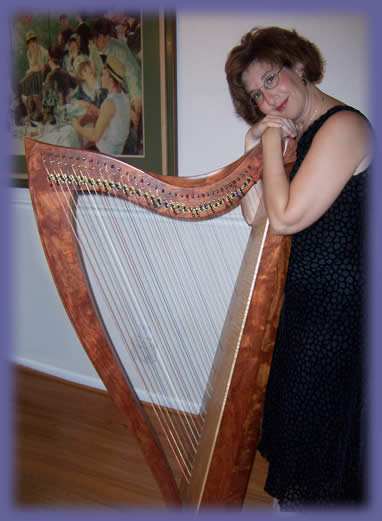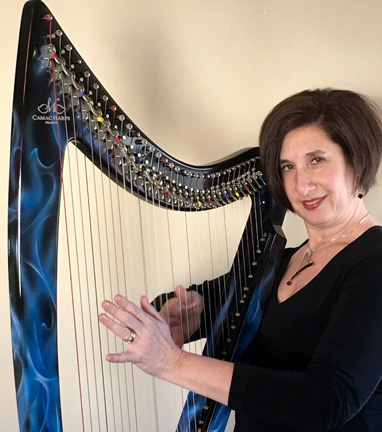

Cheryl's Harps and Amplification System
The Westover Therapy Harp

For Harp Therapy situations, Cheryl plays a 23-string lap harp called the therapy harp made by Westover Harp. Ansel Erickson-Zinter, owner and harp maker extraordinaire of Westover Harp, meticulously handcrafted this harp made from select cherry wood, with a Baltic birch soundboard. Its 23 nylon strings range from C below middle C up to the third D above middle C, with Truitt levers for each string. This harp weighs only 7 pounds and has a strap, making it very portable to play while standing, walking, and dancing. Like all Westover harps, Cheryl's therapy harp produces an exceptionally clear, resonant tone.
Cheryl also plays her Westover therapy harp in non-therapeutic situations. Its portability and beautiful acoustic sound make this harp ideal for many kinds of special occasions.
The Dusty Strings FH36S Harp

For special events and performances, Cheryl plays her Dusty Strings FH36S harp. Dusty Strings, one of the country's prominent harp builders, exquisitely designed this harp with 36 strings and Loveland levers, a range of 5 octaves from 2 Cs below middle C up to the third C above middle C, and a gently arched stave-back. It is made from bubinga, an African rosewood, and the soundboard has solid spruce in the bottom third of the range, mahogany in the top two-thirds, and a book-matched veneer of figured hardward. It weighs about 29 pounds, is an impressive piece of fine woodworking, and produces a warm, rich, clean, and full-bodied sound.
The DHC 32 Blue Light Electric Harp by Camac Harps
 Camac Harps is a French company known for their innovations in harp manufacture, particularly electric harps. This popular carbon fiber electric harp that Cheryl plays was named after the internationally renowned harpist Deborah Henson-Conant, who worked with Camac to design this revolutionary 11 pound electric harp. Each of the 32 strings has a piezoelectric pick-up that is mechanically coupled at its base and requires an amplifier. Its range goes from 2 Cs below middle C to the 3rd F above middle C and produces a rich, resonant, and even sound. Cheryl uses this harp specifically for playing jazz, blues, and rock music.
Camac Harps is a French company known for their innovations in harp manufacture, particularly electric harps. This popular carbon fiber electric harp that Cheryl plays was named after the internationally renowned harpist Deborah Henson-Conant, who worked with Camac to design this revolutionary 11 pound electric harp. Each of the 32 strings has a piezoelectric pick-up that is mechanically coupled at its base and requires an amplifier. Its range goes from 2 Cs below middle C to the 3rd F above middle C and produces a rich, resonant, and even sound. Cheryl uses this harp specifically for playing jazz, blues, and rock music.
The Legend Harp from Heartland Harps
 Cheryl's newest harp, the Legend, is a full-sized 36-string black harp made of carbon fiber. It's extremely lightweight at only 10 pounds, is incredibly durable, and has remarkable tone and volume. These special features allow the harp to be moved easily and played outdoors and exposed to the elements without any damage to the instrument. Unlike wood harps, the carbon fiber harps won't shrink, swell, or warp. So if you are planning a wedding at the beach, or an outdoor party unexpectedly has rain, the Legend is the harp of choice. The Legend has 5 octaves from 2 Cs below middle C up to the third C above middle C, along with beautiful gold plated Truitt levers, soundboard eyelets, tuning and bridge pins. The LED lights under the neck of the harp illuminate the strings and create a stylish appearance.
Cheryl's newest harp, the Legend, is a full-sized 36-string black harp made of carbon fiber. It's extremely lightweight at only 10 pounds, is incredibly durable, and has remarkable tone and volume. These special features allow the harp to be moved easily and played outdoors and exposed to the elements without any damage to the instrument. Unlike wood harps, the carbon fiber harps won't shrink, swell, or warp. So if you are planning a wedding at the beach, or an outdoor party unexpectedly has rain, the Legend is the harp of choice. The Legend has 5 octaves from 2 Cs below middle C up to the third C above middle C, along with beautiful gold plated Truitt levers, soundboard eyelets, tuning and bridge pins. The LED lights under the neck of the harp illuminate the strings and create a stylish appearance.
Harp Amplification System
When a special event requires additional volume, Cheryl can provide the finest quality amplification. She uses a state-of-the-art amplifier for acoustic and electric instruments, the AER Compact 60, which sounds especially great with harps. It emits a crystal clear transparent sound and has many technical features. It weighs less than 17 pounds and is small in size (13 by 9.25 by 10.5 inches) so it fits in easily and has a discreet appearance. Considered by harp experts as the best amplifier for harps, the AER Compact 60 is a marvel of German engineering.
Along with the AER Compact 60 amplifier, Cheryl uses a superb quality microphone, the Harp Mic, specifically created for acoustic harps. Dusty Strings and Applied Microphone Technologies collaboratively designed this harp microphone that is electronically tailored to the harp’s unique sound and mounts easily, when needed, on the back of the soundbox. The microphone unit is so small that it is discreetly hidden from view, and it moves with the harp as it is played, keeping the sound level consistent.